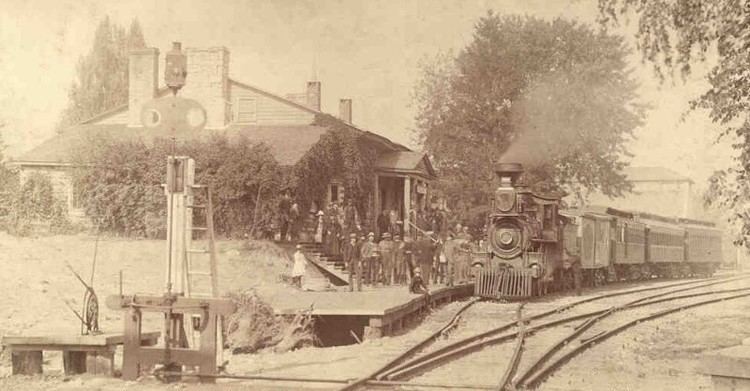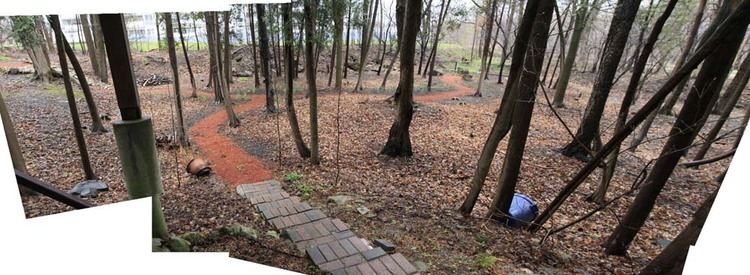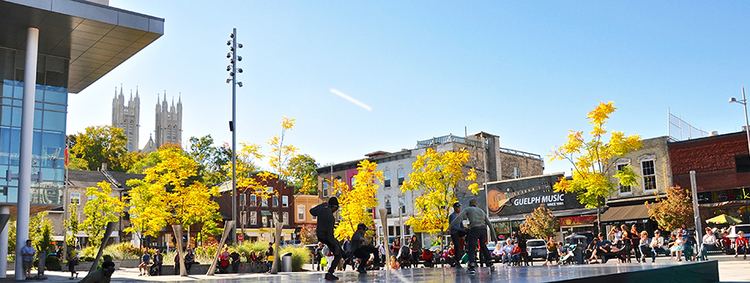Country Canada Province Ontario Area 86.72 km2 Mayor Cam Guthrie2014-Present | Population 114,940 (2006) University University of Guelph Founded April 23, 1827 | |
 | ||
Points of interest Basilica of Our Lady Immaculate, Guelph Civic Museum, University of Guelph Arboretum, McCrae House, Macdonald Stewart Art Centre | ||
Map of Guelph
Guelph (; Canada 2016 Census population 131,794) is a city in southwestern Ontario, Canada. Known as "The Royal City", Guelph is roughly 28 kilometres (17 mi) east of Kitchener and 100 kilometres (62 mi) west of Downtown Toronto, at the intersection of Highway 6 and Highway 7. It is the seat of Wellington County, but is politically independent of it.
Contents
- Map of Guelph
- The best place to live in guelph the ward
- frontrow byob ps 2015 university of guelph atcha crew 2nd place
- History
- After 1878
- Etymology
- Topography and water courses
- Climate
- Economy
- Demographics
- Education
- Secondary schools
- Post secondary institutions
- Public library system
- Museums
- Municipal
- Provincial
- Federal
- Historic sites
- National Historic Sites
- Outdoor attractions
- Festivals
- Arts facilities
- Media
- Entertainment
- Music
- Bus
- Rail
- Highways
- Twin cities
- References

The current Guelph began as a settlement in the 1820s, started by John Galt, originally from Scotland, the first Superintendent of the Canada Company. He based the headquarters, and his home, in the community. The area – much of what became Wellington County – had previously been part of the Halton Block, a Crown Reserve for the Six Nations Iroquois. Galt would later be considered as the founder of Guelph.

Because of its low crime rates, clean environment and generally high standard of living, Guelph is consistently rated as one of Canada's best places to live. Guelph has been noted as having one of the lowest unemployment rates in the country throughout the Great Recession. In February 2016, it had the lowest rate in the country, at 3.9 per cent, compared to the national rate of 7.3 per cent; in large part, this is because of the great number of manufacturing facilities, including Linamar.

For many years, the city ranked at the bottom of Canada's crime severity list. Even after a slight increase, it had the second lowest crime rate in Canada in 2014, at 43 (per 100,000 population); by comparison the national rate was 68.7. In 2016, Guelph was the second best place in Canada to find full-time employment based on data from StatsCan.

The best place to live in guelph the ward
frontrow byob ps 2015 university of guelph atcha crew 2nd place
History
Before colonization, the area was considered by the surrounding indigenous communities to be a "neutral" zone and was inhabited by the Neutral Nation. According to the University of Guelph, "the area was home to a First Nations community called the Attawandaron who lived in longhouses surrounded by fields of corn". (The majority of this nation, about 4,000 people, lived in a village near what is now the Badenoch area of Puslinch, near Morriston.)
John Galt, the first Superintendent of the Canada Company, selected Guelph as the headquarters of British development firm "the Canada Company". Galt was a popular Scottish novelist who also designed the town to attract settlers and farmers to the surrounding countryside. His design intended the town to resemble a European city centre, complete with squares, broad main streets and narrow side streets, resulting in a variety of block sizes and shapes which are still in place today. The street plan was laid out in a radial street and grid system that branches out from downtown, a technique which was also employed in other planned towns of this era, such as Buffalo, New York.
Galt constructed what was one of the first buildings in the community to house early settlers and the Canada Company office; this would eventually become his own home, "The Priory" (built 1827–1828). It was located on the banks of the Speed River near the current River Run Centre for performing arts. The house would eventually become the CPR's Priory station on the Guelph Junction Railway before it was eventually torn down and removed. A historical plaque commemorates John Galt's role with the Canada Company in populating Upper Canada's Huron Tract, calling it "the most important single attempt at settlement in Canadian history". (Galt was responsible for finding settlers for the 42,000 acre Halton Block that would become Guelph and its townships but also for the one million acre Huron Tract that stretched to Goderich, Ontario.)
The initial founding was symbolized by Galt felling a tree on St. George's Day, April 23, 1827, the feast day of the patron saint of England. The town was named to honour Britain's royal family, the Hanoverians, who were descended from the Guelfs, the ancestral family of George IV, the reigning British monarch; thus the nickname The Royal City. The directors of the Canada Company had actually wanted the city to be named Goderich, because Lord Goderich had helped form the company, but reluctantly accepted the fait accompli.
The Smith's Canadian Gazetteer of 1846 indicates that the town had a jail and court house made of cut stone, a weekly newspaper, five churches/chapels and a population of 1,240; most were from England and Scotland with a few from Ireland. In addition to many tradesmen, the community had 15 stores, seven taverns, and some industry, tanneries, breweries, distilleries and a starch factory. The Post Office was receiving mail daily.
In 1869 the population was 3000 and the community's manufacturing companies were served by both the Grand Trunk Railway and the Great Western Railway.
After 1878
Guelph was incorporated as a city in 1879. Despite optimism, the population growth was very slow until the Grand Trunk Railroad reached it from Toronto in 1856; in that year, the village became a town.
A few years later, George Sleeman Sr. founded an electric radial railway, the Guelph Railway Company, which had only five miles of track in 1895, but was extended in 1902; the radial railway eventually reached Toronto, as the Ontario Hydro Electric Railways - Guelph District (owned by Ontario Hydro). In addition to carrying passengers, the cars carted coal to heat the Ontario Agricultural College.
The Canadian Communist Party began as an illegal organization in a rural barn near the town of Guelph, Ontario, on May 28 and 29, 1921.
Guelph was the home of North America's first cable TV system. Fredrick T. Metcalf created MacLean Hunter Television (now part of Rogers Communications) and their first broadcast was Queen Elizabeth's Coronation in 1953.
Guelph's police force had Canada's first municipal motorcycle patrol. Chief Ted Lamb brought back an army motorcycle he used during the First World War. Motorcycles were faster and more efficient than walking.
The city is home to the University of Guelph, established in 1964, and Sleeman Breweries Ltd.. The Ontario Agricultural College (OAC), the oldest part of the University of Guelph, began in 1874 as an associate agricultural college of the University of Toronto. Guelph Collegiate Vocational Institute (GCVI), established in the 1840s, is one of the province's oldest high schools.
Guelph has three buildings on the National Historic Sites of Canada register: the Basilica of Our Lady Immaculate, McCrae House and Old City Hall.
Etymology
The name Guelph comes from the Italian Guelfo and the Bavarian-Germanic Welf. It is a reference to the reigning British monarch at the time Guelph was founded, King George IV, whose family was from the House of Hanover, a younger branch of the House of Welf sometimes spelled as Guelf or Gwelf.
Topography and water courses
Downtown Guelph is situated above the confluence of the Speed River and the Eramosa River, which have numerous tributaries. The Speed River enters from the north and the Eramosa River from the east; the two rivers meet below downtown and continue southwest, where they merge with the Grand River (Ontario). There are also many creeks and smaller rivers creating large tracts of densely forested ravines, and providing ideal sites for parks and recreational trails. The city is built on several drumlins and buried waterways, the most notable being an underground creek flowing below the Albion Hotel, once the source of water used to brew beer.
Climate
This region of Ontario has cold winters and warm, humid summers, falling into the Köppen climate classification Dfb zone, with moderately high rainfall and snowfall. It is generally a couple of degrees cooler than lower elevation regions on the Great Lakes shorelines, especially so in winter, the exception being on some spring afternoons when the lack of an onshore breeze boosts temperatures well above those found lakeside.
The highest temperature ever recorded in Guelph was 38.3 °C (100.9 °F) on 6 August 1918 and 13 July 1936. The coldest temperature ever recorded was −37.2 °C (−35.0 °F) on 25 January 1884.
Economy
The city of Guelph has a diversified economy that helped Guelph obtain the lowest unemployment rate in the country at 4.2 per cent in 2011 and at 3.9 per cent in February 2016. The great diversity in the types of employers is a significant factor too; unlike Windsor, the city is not dependent on a single type of industry. And the so-called "employment rate" (percentage of the population that is working) was the best in Canada in December 2015 was the best in Canada according to BMO senior economist Robert Kavcic. The job growth of more than 9 per cent at the same time was also of great value to the community. This BMO economist also rated Guelph as the top city in Canada for those looking for work.
Manufacturing is the leading sector, accounting for 24.3% of employment (2006 census). The largest industry is auto parts manufacturing while the second largest industry is Educational services, accounting for 11.3%.
According to research completed by the City of Guelph in 2010, Fabricated Metal Product Manufacturing accounted for 26.1% of the types of industries while Machinery Manufacturing for 12.8% and Miscellaneous Manufacturing for 10.4%. The City's Economic Development Strategy identified life science, agri-food and biotechnology firms, environmental management and technology companies as growth industries on which to focus economic development activities.
The City encourages movie and television filming. Parts of many productions have been filmed here, including American Gods (released in 2017), 11.22.63 (2016) with James Franco, Total Recall (2012), Dream House (2011), The Heretics (2017), Dead Rush (2016) and Murdoch Mysteries (2013 and 2015).
Guelph's 3 largest employers include Linamar (8,300), the Upper Grand District School Board (3,400) and the University of Guelph. The University's staffing falls into three categories: there are 2,600 regular full-time faculty and staff, 1,890 temporary (full-time and part-time) and 3,690 student employees.
Demographics
Guelph is the fifth fastest-growing city in Canada with a population growth rate of about 2% per year. According to the Ontario Places to Grow plan, Guelph's population is projected to be about 144,500 by the year 2021. Population varies throughout the year because of variations in the University of Guelph student population.
The 2006 census enumerated 114,943 residents of Guelph. 49.1% were male and 50.9% were female. 6.2% were under five. The average age is 35.7 years of age. Between 1996 and 2001, the population of Guelph grew 10.7%. The 2011 metro population density of Guelph was 335.6 people per square kilometre.
Historically, Guelph's population has been principally British in origin, with 92% in 1880 and 87% in 1921.
The city is mostly Christian (61.8%), almost evenly split among Protestants and Roman Catholics. The largest non-Christian religion is Islam (2.6%), followed by Buddhism (1.9%), Hinduism (1.5%) and Sikhism (1.0%).
Education
Four school boards operate in the city. The Upper Grand District School Board administers all of Wellington County, as well as adjacent Dufferin County, while the Wellington Catholic District School Board administers Catholic education in Wellington County, including Guelph. The Conseil scolaire de district catholique Centre-Sud offers French First language education for students with parents who had elementary and secondary education in French at École Saint-René-Goupil. The Conseil scolaire Viamonde, with similar entrance requirements, operates the École élémentaire L'Odyssée.There are also numerous private schools in Guelph: Cornerstone Canadian Reformed Christian School, Resurrection Christian Academy, Guelph Community Christian School, Guelph Montessori School, Trillium Waldorf School, Wellington Hall Academy, and Wellington Montessori School, Echo Montessori. An International Baccalaureate Program is available at Guelph C.V.I.
Secondary schools
Due to the presence of two different English school boards, Guelph has numerous elementary and secondary schools. The secondary schools are as follows:
Public:
Catholic:
Post-secondary institutions
Public library system
Although a private library had existed since 1832, a public library did not exist in Guelph until 1882, when the Free Libraries Act allowed municipalities to operate libraries. After occupying premises near City Hall, it moved into an Andrew Carnegie-funded building in 1905, which was eventually demolished in 1964. The current main library building on Norfolk St. was opened in 1965.
Guelph is served by a growing library system composed of a main library located in the downtown core, five branches and a Bookmobile. With a membership of over 85,000, the Guelph Public Library system's goals include preserving and indexing public materials relating to the history of Guelph. Although no formal program has been developed, the library acquires municipal records of archival value from the City of Guelph.
A new public library may be built near the Baker St. parking lot, which is to be redeveloped as the Baker District, starting in 2018. Preliminary discussions about a new main branch had taken place by summer 2017.
Museums
The City of Guelph operates Guelph Museums, including the Guelph Civic Museum which showcases the city's history with exhibits, an interactive gallery and special events; this facility has some 30,000 artifacts. The city also operates McCrae House, the birthplace of John McCrae (1872-1918), author of In Flanders Fields.
Municipal
The city is a single-tier municipality governed by a mayor-council system. The structure of the municipal government is stipulated by the Ontario Municipal Act of 2001. There are currently 12 councillors and a mayor, with two councillors representing each of the six wards.
The mayor and members of the city council serve four-year terms without term limits, with the next election in October 2018. Prior to the 2006 election, the mayor and city councillors served three-year terms.
Guelph City Council is responsible for policy and decision making, monitoring the operation and performance of the city, analyzing and approving budgets and determining spending priorities.
In 2014, Ward 4 councillor Cam Guthrie defeated incumbent Karen Farbridge, 50% to 36% for the position of mayor. Five incumbent councillors were re-elected, four rookie councillors were elected, three former councillors were elected, two incumbents were defeated, and four did not seek re-election.
Provincial
Guelph occupies a single provincial riding of the same name, and is currently represented in the Legislative Assembly of Ontario by Liz Sandals, a member of the ruling Ontario Liberal Party. Sandals was named Ontario's Minister of Education in February 2013 and served in this role for three years. Subsequently, in 2016, she was appointed President of the Treasury Board.
Federal
Guelph also occupies a federal riding of the same name. The member of Parliament is Lloyd Longfield of the Liberal Party of Canada.
Historic sites
National Historic Sites
Outdoor attractions
Most of the natural attractions of Guelph are located beside the two rivers which pass inside the city, Speed River and Eramosa River.
Festivals
Arts facilities
Media
The earliest newspaper published here was the Guelph Herald, which lasted for nine months after its was started in 1842 by Charles McDonnell. The Wellingtonian also lasted for only a short time in 1843. The next one to be published was The Advertiser in 1845. In 1847, the new Guelph Herald was established as a weekly.
Both of those publications disappeared but the city was served by a daily newspaper for 149 years until the Guelph Mercury ceased operations in January 2016 due to declining subscriptions and revenues. At the time, it was owned by Metroland Media Group which also owned the Guelph Tribune, a twice weekly publication with limited news coverage. The latter increased its reporting of local news, assumed publication of the Guelph and District Homes section and, in April 2016, took over operation of the Mercury web site. At the same time, the newspaper rebranded with a new title, Guelph Mercury Tribune.
The city is served by two radio stations Magic 106.1, CIMJ-FM, featuring hot adult contemporary music branded as Today's Best Mix and CJOY, 1460, broadcasting an oldies format and branded as Greatest Hits. Both stations have been owned by Corus Entertainment since 2000. The University of Guelph station 93.3 CFRU-FM, Campus and Community Radio, has been broadcasting since 1980, currently at 250 watts.
Radio stations from Kitchener-Waterloo and CTV Kitchener, CKCO-DT television, also provide some coverage of Guelph news. Since 2011, CKCO has not been identified by its call letters.
Entertainment
The Sleeman Centre is a sports and entertainment venue in Guelph. The large, modern facility allows for a variety of events such as concerts, sporting and family events, trade shows and conferences, and it is home to the local hockey team, the Guelph Storm.
Music
From a Bell Organ factory to the opera singer Edward Johnson, Guelph has been a source of musical contribution. Today, Guelph has a thriving indie rock scene, which has spawned some of Canada's more well-known indie bands. Guelph is also home to the Hillside Festival, a hugely popular music festival held at nearby Guelph Lake during the summer, as well as the Guelph Jazz Festival.
Guelph is also home to the Guelph Symphony Orchestra, and two yearly classical music festivals. The Kiwanis Music Festival of Guelph showcases students from Guelph and surrounding areas, while the Guelph Musicfest offers performances by local professional classical musicians.
Bus
Guelph Transit provides local transportation around the city. On June 20, 2007, Guelph Transit launched a web-based system known as Next Bus. Global positioning satellites (GPS) technology and advanced computer modelling provide riders via the Internet, handheld devices (including Palms, Blackberries, and Web-capable cellular phones), or their telephones to receive accurate, real-time arrival and departure information. Intercity connections by GO Transit and Greyhound Canada are made at the Guelph Central Station.
Rail
Guelph was the first municipality in Canada to have its own federally chartered railway, the Guelph Junction Railway. This 25 kilometre (16 mile) link to the CPR is still municipally owned.
Built in 1911, the Guelph Central Station (still in use), was constructed by the Grand Trunk Railway which had arrived in Guelph in 1856; years later, it was taken over by the Canadian National Railway. This is a classic example of early 20th Century Canadian railway station design and has been designated as a heritage structure per the Heritage Railway Stations Protection Act. The Romanesque Revival building, with its Italianate tower, has been listed on the Canadian Register since 2006 and was formally recognized as one of Canada's Historic Places in November 1992. A renovation project in 2016-2017 provided various benefits, including repairs to maintain and restore heritage aspects.
There had also been passenger stations in Guelph that were built by the Canadian Pacific Railway. The first CPR station, from the 1800s, was the Priory House station, converted from the first house in Guelph. It stood opposite the current Priory Square and was eventually dismantled. Its replacement, located between Cardigan Street and the Speed River, was a brick building erected in 1911. After this brick building was no longer used as a rail station, it was converted for other purposes; eventually it was moved to the Galt area of Cambridge, Ontario.
The Central station is currently an Intermodal Transit Terminal that includes bus and railway services in one facility. The following is a summary of its purpose from an April 2017 report:
"Guelph Central Train Station is a busy transit hub that accommodates Guelph Transit, GO Transit, Via Rail and Greyhound Canada operations. Each weekday, more than 5,000 passengers board Guelph Transit, to travel on one of the 15 different routes that operate out of the bus bays adjacent to the train station."
